The Effect of Electricity Generation on the Performance of Microbial Fuel Cells for Anammox
Abstract
1. Introduction
2. Materials and Methods
2.1. Experimental Setup
2.2. Influent Wastewater Composition
2.3. Inoculum Sludge
2.4. Analysis and Calculations
2.5. Sequencing Using the Macrogene Platform
2.5.1. Extraction of DNA from Environmental Samples
2.5.2. Reconstructing a Physical Education Library
2.5.3. PCR Amplification and Sequencing
2.5.4. The Process of Bioinformatics Analysis
3. Results and Discussion
3.1. The Impact of COD on Nitrogen Removal and Energy Production
3.2. The Impact of Electricity Generation on Nitrogen Removal
3.3. Change in Sludge Concentration and Bioparticle Analysis
3.4. Microbial Community Analysis
4. Conclusions
5. Discussion
Supplementary Materials
Author Contributions
Funding
Informed Consent Statement
Data Availability Statement
Conflicts of Interest
References
- Ge, S.J.; Agbakpe, M.; Wu, Z.Y.; Kuang, L.Y.; Zhang, W.; Wang, X.Q. Influences of Surface Coating, UV Irradiation and Magnetic Field on the Algae Removal Using Magnetite Nanoparticles. Environ. Sci. Technol. 2015, 49, 1190–1196. [Google Scholar] [CrossRef]
- Huang, J.Y.; Kankanamge, N.R.; Chow, C.; Welsh, D.T.; Li, T.L.; Teasdale, P.R. Removing ammonium from water and wastewater using cost-effective adsorbents: A review. J. Environ. Sci. 2018, 63, 174–197. [Google Scholar] [CrossRef] [PubMed]
- Yu, C.Q.; Huang, X.; Chen, H.; Godfray, H.C.J.; Wright, J.S.; Hall, J.W.; Gong, P.; Ni, S.Q.; Qiao, S.C.; Huang, G.R.; et al. Managing nitrogen to restore water quality in China. Nature 2019, 567, 516–520. [Google Scholar] [CrossRef] [PubMed]
- Zou, L.; Qiao, Y.; Li, C.M. Boosting Microbial Electrocatalytic Kinetics for High Power Density: Insights into Synthetic Biology and Advanced Nanoscience. Electrochem. Energy Rev. 2018, 1, 567–598. [Google Scholar] [CrossRef]
- Kuenen, J.G. Anammox bacteria: From discovery to application. Nat. Rev. Microbiol. 2008, 6, 320–326. [Google Scholar] [CrossRef] [PubMed]
- Zhang, Z.W.; Xu, C.Y.; Han, H.J.; Zheng, M.Q.; Shi, J.X.; Ma, W.C. Effect of low-intensity electric current field and iron anode on biological nitrate removal in wastewater with low COD to nitrogen ratio from coal pyrolysis. Bioresour. Technol. 2020, 306, 123123. [Google Scholar] [CrossRef] [PubMed]
- Zhang, F.; He, Z. A cooperative microbial fuel cell system for waste treatment and energy recovery. Environ. Technol. 2013, 34, 1905–1913. [Google Scholar] [CrossRef] [PubMed]
- Bian, B.; Shi, D.; Cai, X.B.; Hu, M.J.; Guo, Q.Q.; Zhang, C.H.; Wang, Q.; Sun, A.X.; Yang, J. 3D printed porous carbon anode for enhanced power generation in microbial fuel cell. Nano Energy 2018, 44, 174–180. [Google Scholar] [CrossRef]
- Logan, B.E.; Hamelers, B.; Rozendal, R.A.; Schrorder, U.; Keller, J.; Freguia, S.; Aelterman, P.; Verstraete, W.; Rabaey, K. Microbial fuel cells: Methodology and technology. Environ. Sci. Technol. 2006, 40, 5181–5192. [Google Scholar] [CrossRef]
- Do, M.H.; Ngo, H.H.; Guo, W.S.; Liu, Y.; Chang, S.W.; Nguyen, D.D.; Nghiem, L.D.; Ni, B.J. Challenges in the application of microbial fuel cells to wastewater treatment and energy production: A mini review. Sci. Total Environ. 2018, 639, 910–920. [Google Scholar] [CrossRef]
- Pant, D.; Van Bogaert, G.; Diels, L.; Vanbroekhoven, K. A review of the substrates used in microbial fuel cells (MFCs) for sustainable energy production. Bioresour. Technol. 2010, 101, 1533–1543. [Google Scholar] [CrossRef] [PubMed]
- He, Z.; Kan, J.J.; Wang, Y.B.; Huang, Y.L.; Mansfeld, F.; Nealson, K.H. Electricity Production Coupled to Ammonium in a Microbial Fuel Cell. Environ. Sci. Technol. 2009, 43, 3391–3397. [Google Scholar] [CrossRef] [PubMed]
- Zhang, J.Q. Simultaneous Nitrogen Removal and Electricity Generation in Microbial Fuel Cell and Its Mechanism; Zhejiang University: Hangzhou, China, 2014. [Google Scholar]
- Li, C.; Ren, H.Q.; Xu, M.; Cao, J.S. Study on anaerobic ammonium oxidation process coupled with denitrification microbial fuel cells (MFCs) and its microbial community analysis. Bioresour. Technol. 2015, 175, 545–552. [Google Scholar] [CrossRef] [PubMed]
- Xu, M.Y.; Zhou, S.Q.; Liu, Z.J. Study on performance of dual-chamber MFC coupled with Anammox process in a high nitrogen load circumstancel. Acta Sci. Circumstantiae 2016, 37, 154–161. [Google Scholar] [CrossRef]
- Song, C.K.; Wang, Y.Y.; Han, H.C. Effect of decreasing temperature on the performance and extracellular polymer substanceof anaerobic ammonia oxidation sludge. China Environ. Sci. 2016, 36, 2006–2013. [Google Scholar]
- Yu, C.P.; Liang, Z.H.; Das, A.; Hu, Z.Q. Nitrogen removal from wastewater using membrane aerated microbial fuel cell techniques. Water Res. 2011, 45, 1157–1164. [Google Scholar] [CrossRef]
- Chen, Z.H.; Huang, Y.; Li, X. Effect of PH on nitrogen conversion performance in the nitrification, ANAMMOX and combined process. Environ. Eng. 2016, 34, 55–60. [Google Scholar] [CrossRef]
- Chamchoi, N.; Nitisoravut, S.; Schmidt, J.E. Inactivation of ANAMMOX communities under concurrent operation of anaerobic ammonium oxidation (ANAMMOX) and denitrification. Bioresour. Technol. 2008, 99, 3331–3336. [Google Scholar] [CrossRef]
- The State Environmental Protection Administration; The Water and Wastewater Monitoring Analysis Method Editorial Board. Water and Wastewater Monitoring and Analysis Methods, 4th ed.; China Environmental Science Press: Beijing, China, 2002. [Google Scholar]
- Vázquez-Padín, J.R.; Pozo, M.J.; Jarpa, M.; Figueroa, M.; Franco, A.; Mosquera-Corral, A.; Campos, J.L.; Méndez, R. Treatment of anaerobic sludge digester effluents by the CANON process in an air pulsing SBR. J. Hazard. Mater. 2009, 166, 336–341. [Google Scholar] [CrossRef]
- Qiao, S.; Yin, X.; Zhou, J.T. Integrating anammox with autotrophic denitrification process by electrochemistry technology. Chemosphere 2018, 195, 817–824. [Google Scholar] [CrossRef]
- Hassan, M.; Wei, H.W.; Qiu, H.J.; Su, Y.L.; Jaafry, S.W.H.; Zhan, L.; Xie, B. Power generation and pollutants removal from landfill leachate in microbial fuel cell: Variation and influence of anodic microbiomes. Bioresour. Technol. 2018, 247, 434–442. [Google Scholar] [CrossRef] [PubMed]
- Kang, D.; Zheng, P.; Hu, Q.Y. Structure, morphology and function of Anammox granular sludge. CIESC J. 2016, 67, 4040–4046. (In Chinese) [Google Scholar]
- Chen, H.; Ma, C.; Yang, G.F.; Wang, H.Z.; Yu, Z.M.; Jin, R.C. Floatation of flocculent and granular sludge in a high-loaded anammox reactor. Bioresour. Technol. 2014, 169, 409–415. [Google Scholar] [CrossRef] [PubMed]
- Tang, C.J.; Duan, C.S.; Yu, C.; Song, Y.X.; Chai, L.Y.; Xiao, R.Y.; Wei, Z.S.; Min, X.B. Removal of nitrogen from wastewaters by anaerobic ammonium oxidation (ANAMMOX) using granules in upflow reactors. Environ. Chem. Lett. 2017, 15, 311–328. [Google Scholar] [CrossRef]
- Zhu, G.B.; Wang, S.Y.; Ma, B.; Wang, X.X.; Zhou, J.M.; Zhao, S.Y.; Liu, R.P. Anammox granular sludge in low-ammonium sewage treatment: Not bigger size driving better performance. Water Res. 2018, 142, 147–158. [Google Scholar] [CrossRef] [PubMed]
- Song, Y.X.; Liao, Q.; Yu, C.; Xiao, R.Y.; Tang, C.J.; Chai, L.Y.; Duan, C.S. Physicochemical and microbial properties of settled and floating anammox granules in upflow reactor. Biochem. Eng. J. 2017, 123, 75–85. [Google Scholar] [CrossRef]
- Strous, M.; Pelletier, E.; Mangenot, S.; Rattei, T.; Lehner, A.; Taylor, M.W.; Horn, M.; Daims, H.; Bartol-Mavel, D.; Wincker, P.; et al. Deciphering the evolution and metabolism of an anammox bacterium from a community genome. Nature 2006, 440, 790–794. [Google Scholar] [CrossRef]
- Miura, Y.; Watanabe, Y.; Okabe, S. Significance of Chloroflexi in performance of submerged membrane Bioreactors (MBR) treating municipal wastewater. Environ. Sci. Technol. 2007, 41, 7787–7794. [Google Scholar] [CrossRef]
- Wei, Z.S.; He, Y.M.; Huang, Z.S.; Xiao, X.L.; Li, B.L.; Ming, S.; Cheng, X.L. Photocatalytic membrane combined with biodegradation for toluene oxidation. Ecotoxicol. Environ. Saf. 2019, 184, 109618. [Google Scholar] [CrossRef]
- Zhu, K.L.; Wang, S.F.; Liu, H.; Liu, S.J.; Zhang, J.; Yuan, J.X.; Fu, W.C.; Dang, W.H.; Xu, Y.H.; Yang, X.; et al. Heteroatom-doped porous carbon nanoparticle-decorated carbon cloth (HPCN/CC) as efficient anode electrode for microbial fuel cells (MFCs). J. Clean. Prod. 2022, 336, 130374. [Google Scholar] [CrossRef]
- Ding, S.; Zheng, P.; Lu, H.F.; Chen, J.W.; Mahmood, Q.; Abbas, G. Ecological characteristics of anaerobic ammonia oxidizing bacteria. Appl. Microbiol. Biotechnol. 2013, 97, 1841–1849. [Google Scholar] [CrossRef]
- Han, F.; Wei, D.; Ngo, H.H.; Guo, W.S.; Xu, W.Y.; Du, B.; Wei, Q. Performance, microbial community and fluorescent characteristic of microbial products in a solid-phase denitrification biofilm reactor for WWTP effluent treatment. J. Environ. Manag. 2018, 227, 375–385. [Google Scholar] [CrossRef] [PubMed]
- Zhang, B.; Li, W.; Wu, L.; Shi, W.X.; Lens, P.N.L. Rapid start-up of photo-granule process in a photo-sequencing batch reactor under low aeration conditions: Effect of inoculum AGS size. Sci. Total Environ. 2022, 820, 153204. [Google Scholar] [CrossRef] [PubMed]
- Malmqvist, A.; Welander, T.; Moore, E.; Ternstrom, A.; Molin, G.; Stenstrom, I.M. Ideonella-dechloratans gen-nov, sp-nov, a new bacterium capable of growing anaerobically with chlorate as an electron-acceptor. Syst. Appl. Microbiol. 1994, 17, 58–64. [Google Scholar] [CrossRef]
- Kim, G.T.; Webster, G.; Wimpenny, J.W.T.; Kim, B.H.; Kim, H.J.; Weightman, A.J. Bacterial community structure, compartmentalization and activity in a microbial fuel cell. J. Appl. Microbiol. 2006, 101, 698–710. [Google Scholar] [CrossRef] [PubMed]
- Chung, K.; Fujiki, I.; Okabe, S. Effect of formation of biofilms and chemical scale on the cathode electrode on the performance of a continuous two-chamber microbial fuel cell. Bioresour. Technol. 2011, 102, 355–360. [Google Scholar] [CrossRef]
- Wang, Z.J.; Zheng, Y.; Xiao, Y.; Wu, S.; Wu, Y.C.; Yang, Z.H.; Zhao, F. Analysis of oxygen reduction and microbial community of air-diffusion biocathode in microbial fuel cells. Bioresour. Technol. 2013, 144, 74–79. [Google Scholar] [CrossRef]
- Liu, H.; Logan, B.E. Electricity generation using an air-cathode single chamber microbial fuel cell in the presence and absence of a proton exchange membrane. Environ. Sci. Technol. 2004, 38, 4040–4046. [Google Scholar] [CrossRef]
- Zhang, G.D.; Zhao, Q.L.; Jiao, Y.; Zhang, J.N.; Jiang, J.Q.; Ren, N.; Kim, B.H. Improved performance of microbial fuel cell using combination biocathode of graphite fiber brush and graphite granules. J. Power Sources 2011, 196, 6036–6041. [Google Scholar] [CrossRef]
- Yang, N.; Zhan, G.Q.; Li, D.P.; Wang, X.; He, X.H.; Liu, H. Complete nitrogen removal and electricity production in Thauera-dominated air-cathode single chambered microbial fuel cell. Chem. Eng. J. 2019, 356, 506–515. [Google Scholar] [CrossRef]
- Zuo, Y.; Xing, D.F.; Regan, J.M.; Logan, B.E. Isolation of the exoelectrogenic bacterium Ochrobactrum anthropi YZ-1 by using a U-tube microbial fuel cell. Appl. Environ. Microbiol. 2008, 74, 3130–3137. [Google Scholar] [CrossRef]
- Wang, H.Y.; Lyu, W.L.; Hu, X.L.; Chen, L.; He, Q.L.; Zhang, W.; Song, J.Y.; Wu, J. Effects of current intensities on the performances and microbial communities in a combined bio-electrochemical and sulfur autotrophic denitrification (CBSAD) system. Sci. Total Environ. 2019, 694, 133775. [Google Scholar] [CrossRef] [PubMed]
- Lee, Y.; Martin, L.; Grasel, P.; Tawfiq, K.; Chen, G. Power generation and nitrogen removal of landfill leachate using microbial fuel cell technology. Environ. Technol. 2013, 34, 2727–2736. [Google Scholar] [CrossRef] [PubMed]
- Guo, Y.L.; Wei, X.; Zhang, S.H. Simultaneous removal of organics, sulfide and ammonium coupled with electricity generation in a loop microbial fuel cell system. Bioresource Technol. 2020, 305, 123082. [Google Scholar] [CrossRef] [PubMed]
- Li, Y.; Xu, Z.H.; Cai, D.Y.; Holland, B.; Li, B.K. Self-sustained high-rate anammox: From biological to bioelectrochemical processes. Environ. Sci.-Water Res. Technol. 2016, 2, 1022–1031. [Google Scholar] [CrossRef]
- Zekker, I.; Bhowmick, G.D.; Priks, H.; Nath, D.; Rikmann, E.; Jaagura, M.; Tenno, T.; Tämm, K.; Ghangrekar, M.M. ANAMMOX-denitrification biomass in microbial fuel cell to enhance the electricity generation and nitrogen removal efficiency. Biodegradation 2020, 31, 249–264. [Google Scholar] [CrossRef]
- Kong, Z.Y.; Zhou, Y.H.; Fu, Z.M.; Zhang, Y.C.; Yan, R. Mechanism of stable power generation and nitrogen removal in the ANAMMOX-MFC treating low C/N wastewater. Chemosphere 2022, 296, 133937. [Google Scholar] [CrossRef]
- Zhang, L.; Jiang, M.H.; Zhou, S.G. Conversion of nitrogen and carbon in enriched paddy soil by denitrification coupled with anammox in a bioelectrochemical system. J. Environ. Sci. 2022, 111, 197–207. [Google Scholar] [CrossRef]

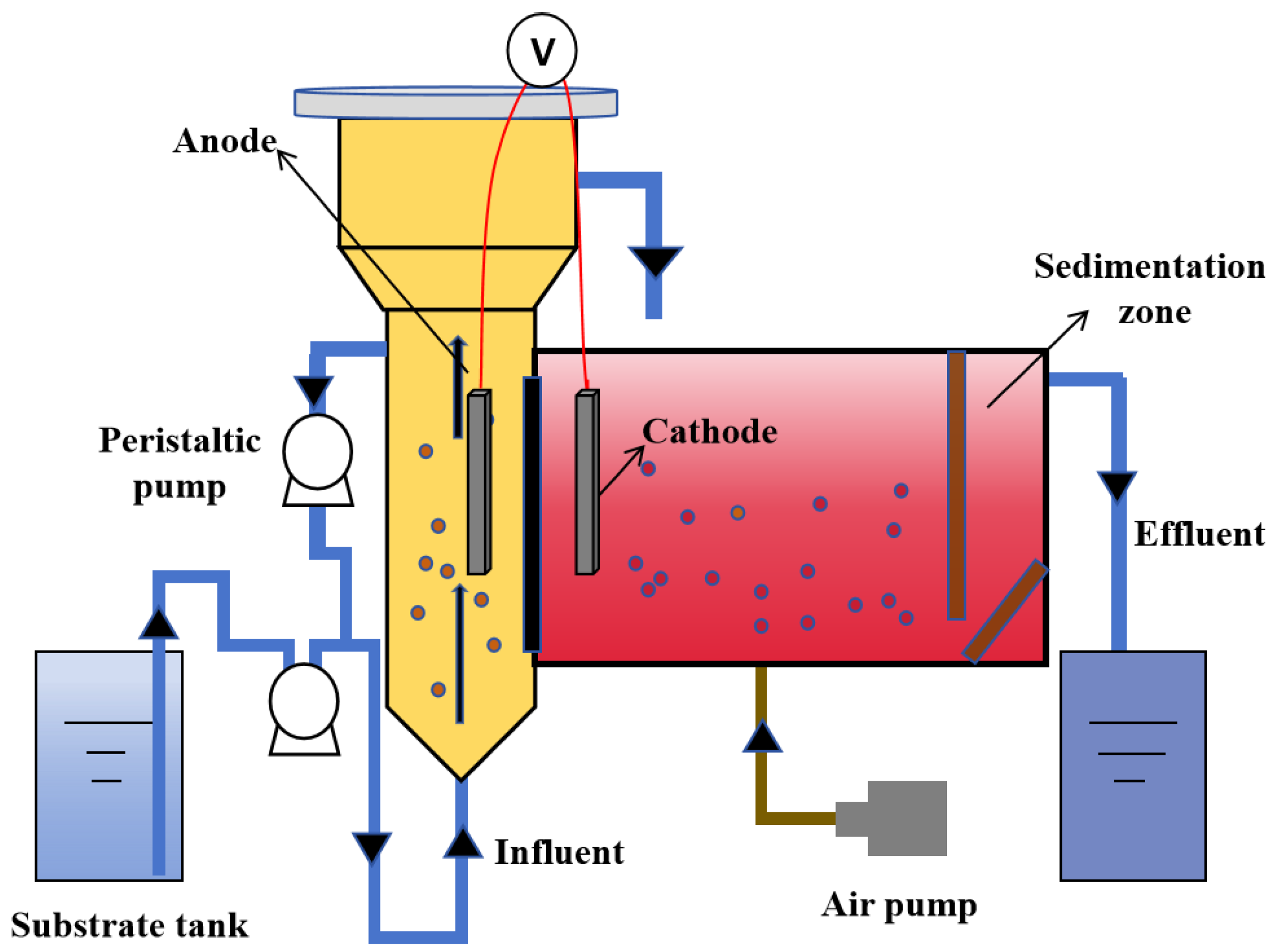
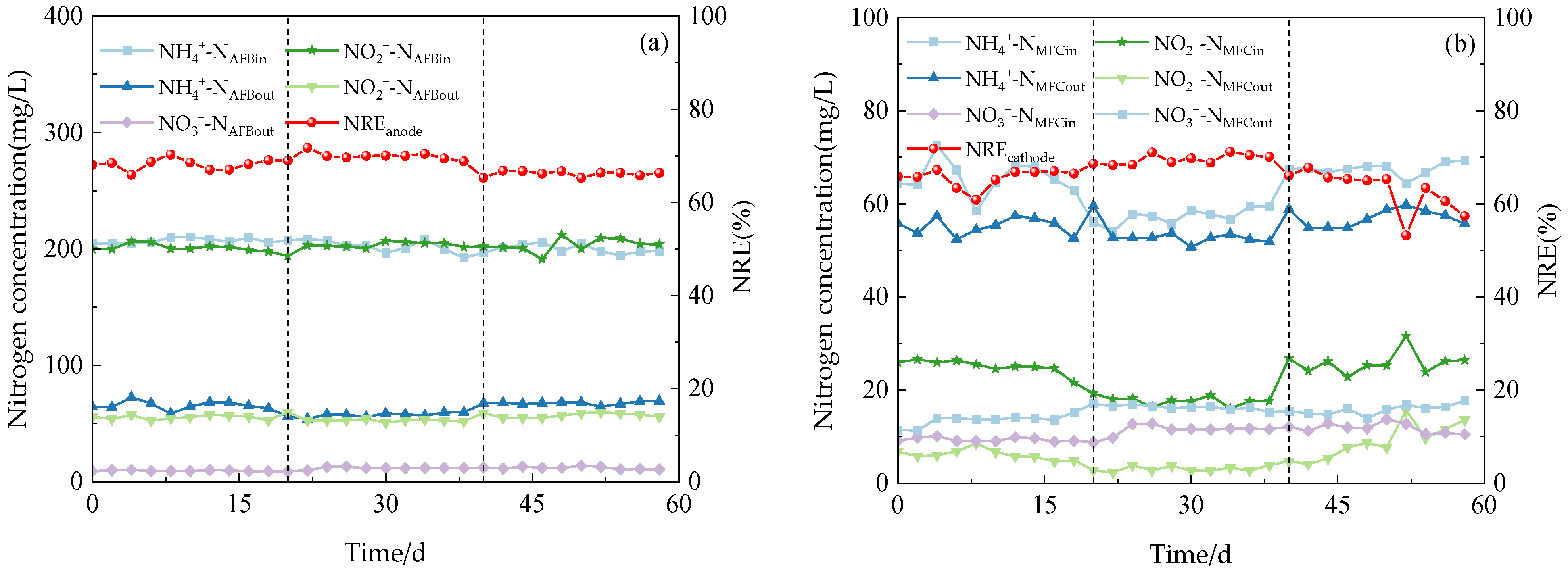
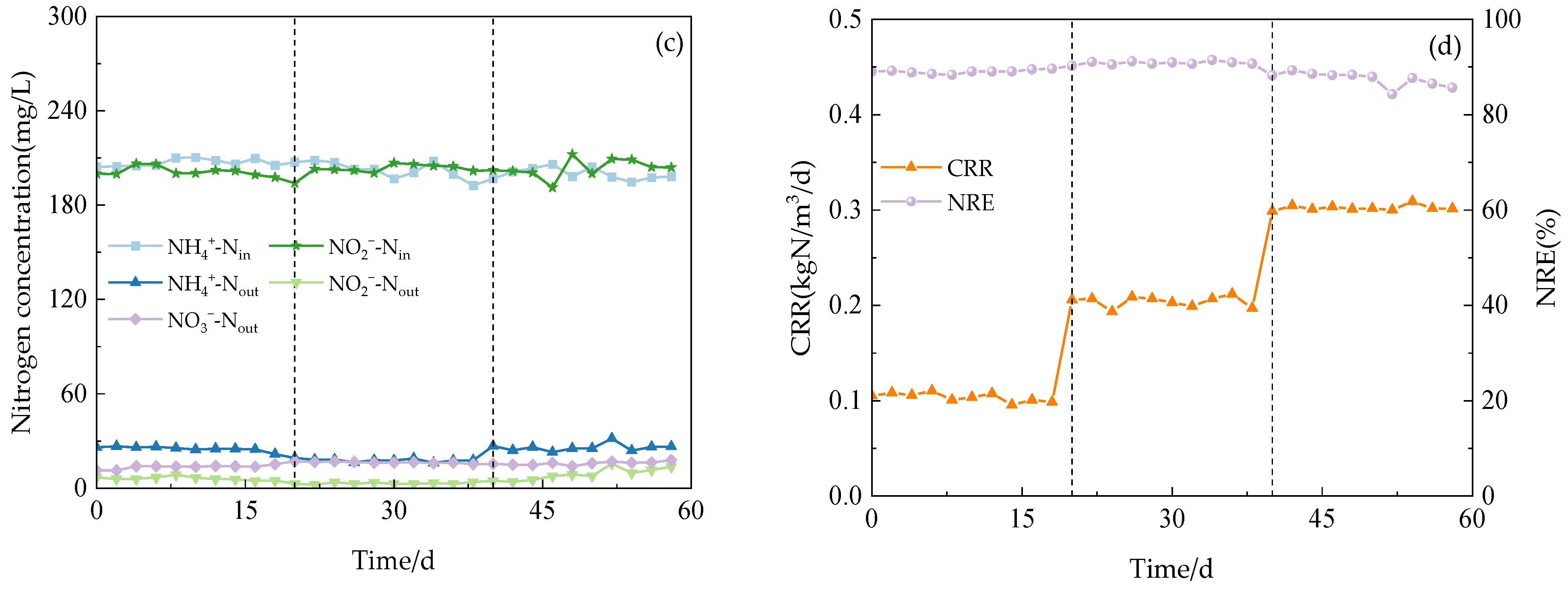
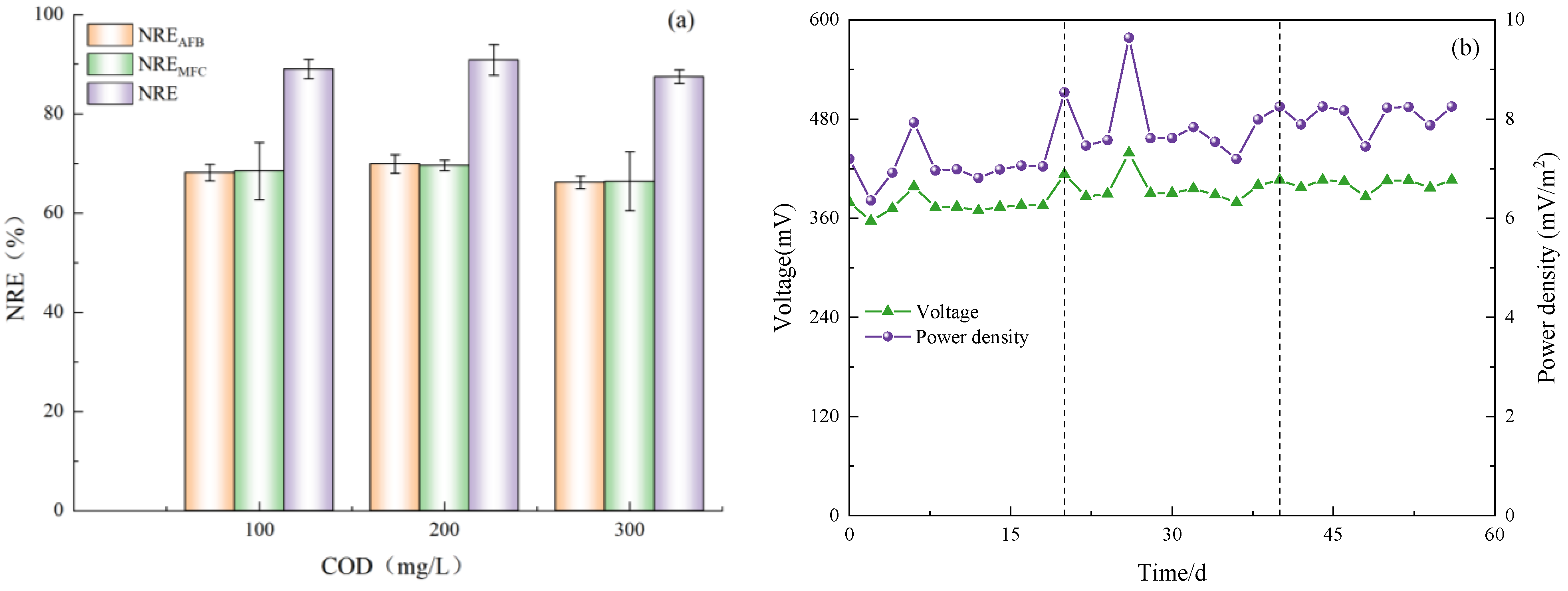
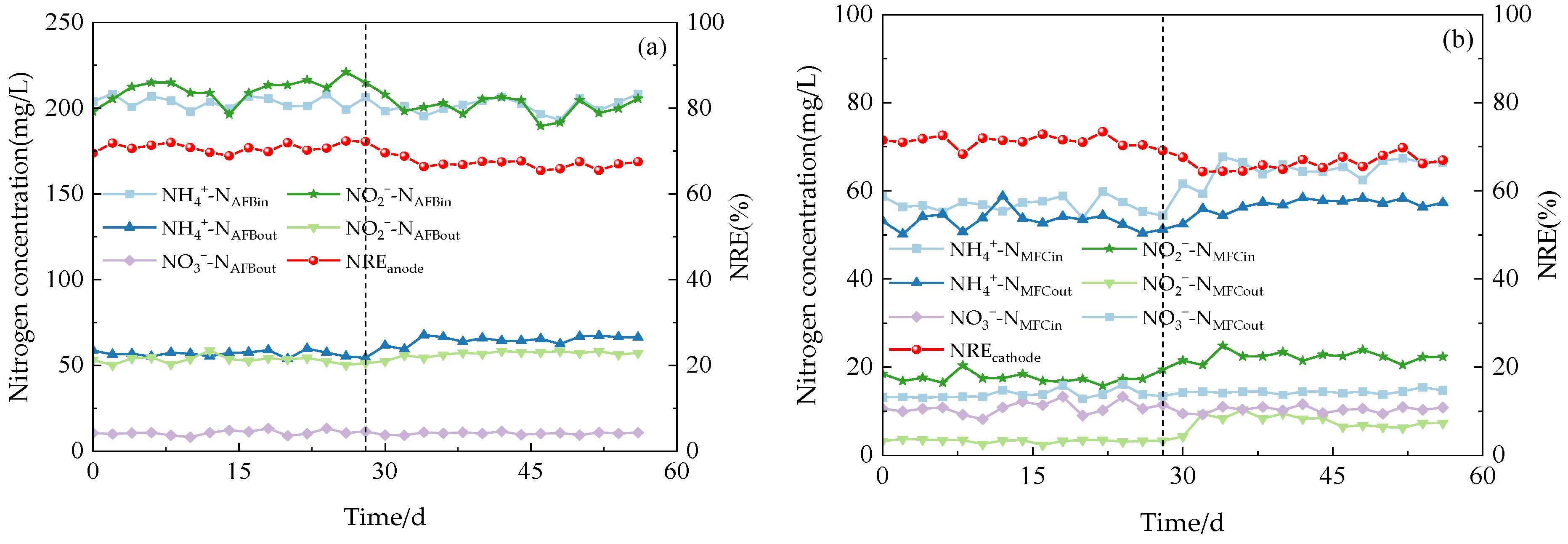



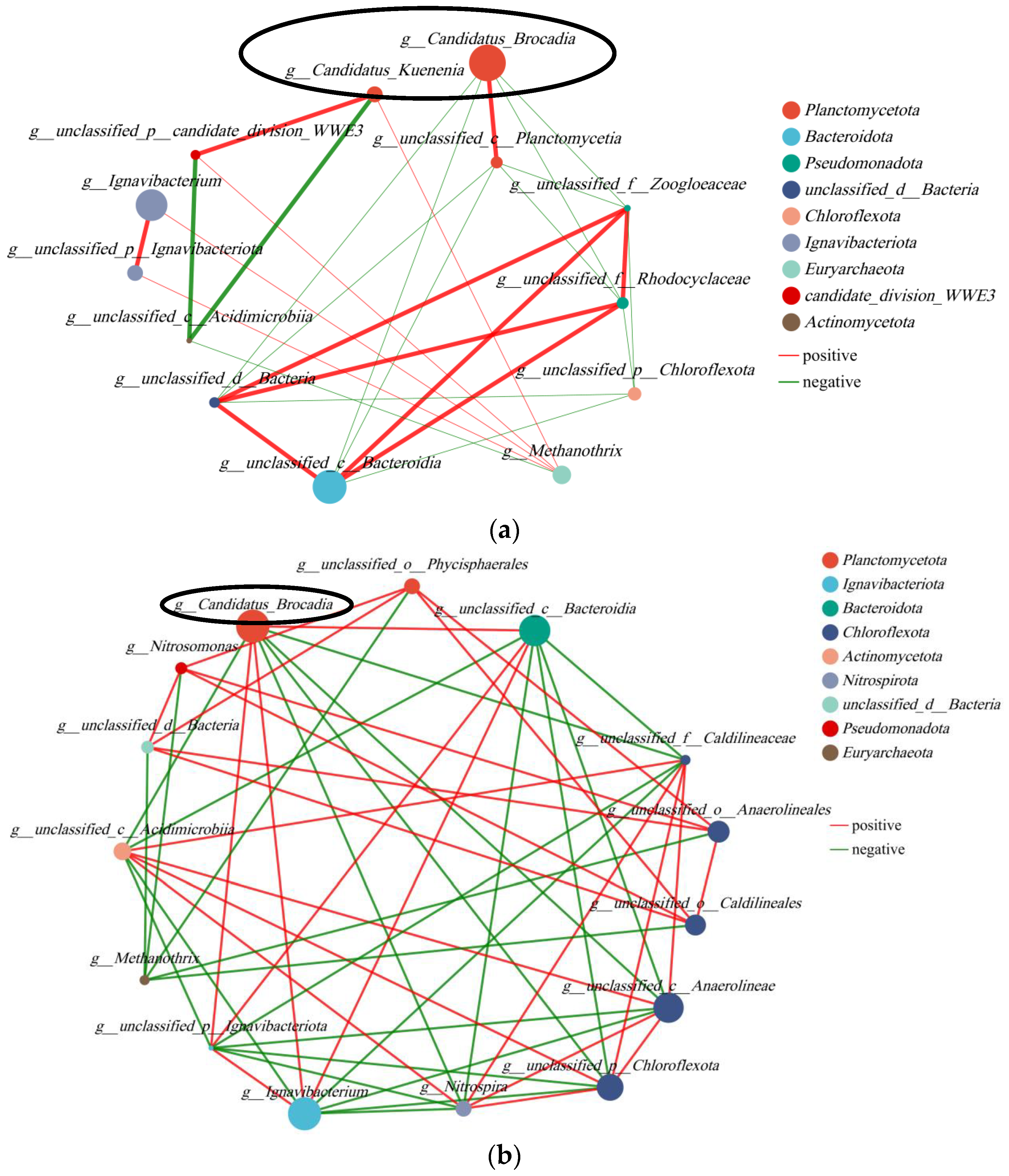
| Phase | Duration (d) | HRT (h) | NH4+-Nin (mg/L) | NO2−-Nin (mg/L) | DO (mg/L) | COD (mg/L) |
|---|---|---|---|---|---|---|
| I | 1~21 | 12 | 200 | 200 | 0.5~1.0 | 100 |
| II | 22~41 | 12 | 200 | 200 | 0.5~1.0 | 200 |
| III | 42~60 | 12 | 200 | 200 | 0.5~1.0 | 300 |
| Phase | Duration (d) | HRT (h) | NH4+-Nin (mg/L) | NO2−-Nin (mg/L) | DO (mg/L) | COD (mg/L) | Circuit (Open/Closed) |
|---|---|---|---|---|---|---|---|
| I | 1~30 | 12 | 200 | 200 | 0.5~1.0 | 200 | closed |
| II | 31~58 | 12 | 200 | 200 | 0.5~1.0 | 200 | open |
Disclaimer/Publisher’s Note: The statements, opinions and data contained in all publications are solely those of the individual author(s) and contributor(s) and not of MDPI and/or the editor(s). MDPI and/or the editor(s) disclaim responsibility for any injury to people or property resulting from any ideas, methods, instructions or products referred to in the content. |
© 2024 by the authors. Licensee MDPI, Basel, Switzerland. This article is an open access article distributed under the terms and conditions of the Creative Commons Attribution (CC BY) license (https://creativecommons.org/licenses/by/4.0/).
Share and Cite
Jiang, W.; Zhang, J.; Yang, Q.; Yang, P. The Effect of Electricity Generation on the Performance of Microbial Fuel Cells for Anammox. Sustainability 2024, 16, 2705. https://doi.org/10.3390/su16072705
Jiang W, Zhang J, Yang Q, Yang P. The Effect of Electricity Generation on the Performance of Microbial Fuel Cells for Anammox. Sustainability. 2024; 16(7):2705. https://doi.org/10.3390/su16072705
Chicago/Turabian StyleJiang, Wenqin, Jian Zhang, Qiulin Yang, and Ping Yang. 2024. "The Effect of Electricity Generation on the Performance of Microbial Fuel Cells for Anammox" Sustainability 16, no. 7: 2705. https://doi.org/10.3390/su16072705
APA StyleJiang, W., Zhang, J., Yang, Q., & Yang, P. (2024). The Effect of Electricity Generation on the Performance of Microbial Fuel Cells for Anammox. Sustainability, 16(7), 2705. https://doi.org/10.3390/su16072705





